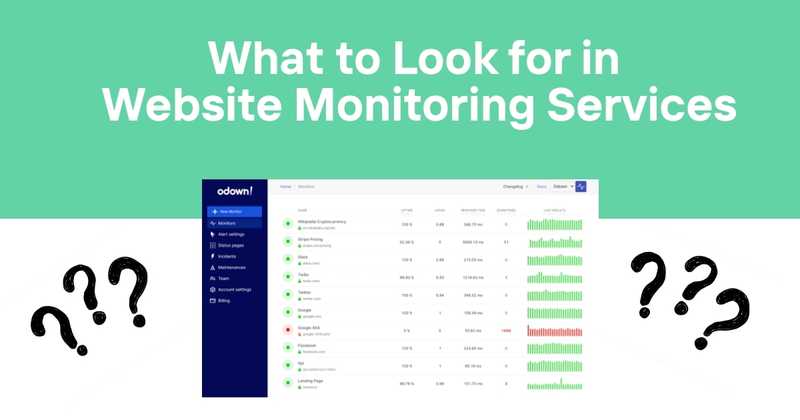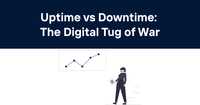What to Look for in Website Monitoring Services
Put yourself in the shoes of your users and imagine coming to a website looking to make a purchase or seeking support, only to discover web services are down. Not only are you unable to get what you need, but now, you may look at the business in a negative light - viewing them as unreliable.
This is why website monitoring tools are important. They ensure that web managers are the first to know about downtime so they can form a swift response and restore functionality before real users are impacted.
But with so many different options at your disposal, it’s not easy to choose one that aligns with your unique needs. It can feel overwhelming sorting through the hundreds of services all claiming to be the best.
Fortunately, our guide on what to look for in website monitoring services will leave you with a crystal clear understanding of what separates the best uptime monitoring service from the rest. Here are the most important criteria:
- Variety of Monitoring Types
- Frequency of Monitoring
- Global Testing Network
- Error Verification
- Alerting and Reporting Features
- Integration Capabilities
- User Experience
- Support and Customer Service
- Pricing
We’ll offer more context on the role each of these factors plays in just a few moments. But, if you just want to skip to the good part and start protecting your digital presence and enjoying peace of mind, look no further than Odown’s website monitoring service.
It’s the most comprehensive, all-in-one solution with built-in incident management features to help you avoid lost revenue and eroded customer trust associated with downtime. Start your 14-day trial today!
Overview of Website Monitoring
First, we need to cover the basics - what is website monitoring? As we’ve briefly touched on above, these tools continuously scrutinize a website's health, performance, and availability.
The primary goal is to keep a website accessible to users at all times, functioning as intended, and delivering a consistent experience across all interactions worldwide. Anytime web errors are detected, an admin is notified.
This could range from a complete website outage to slower than usual page load times which could deter users and impact user experience negatively. The objective is simple: identify problems before they affect users and rectify them swiftly to minimize downtime.
There are two main types of monitoring: synthetic monitoring, which simulates user experiences, and real user monitoring (RUM), which gives you a better idea of the experiences users have on your website.
They differ slightly but share the common goal of identifying problems and optimizing user experience. After all, any disruption in service not only affects sales and productivity but can also harm a company's reputation.
This is why it’s worth taking the time to do your due diligence into the different web monitoring services you have to choose from - but before we help you pick the right service, we need to talk about what you should look for in the first place.
What to Look for in Website Monitoring Services
You know you need web monitoring tools, but how can you be sure you’re protecting your digital presence with a dependable solution? You just need to know what to look for in website monitoring services! We’ll describe the most important features to prioritize below and help you weigh your options.
Variety of Monitoring Types
There are many different angles you can monitor your site from.
Are you just looking to ensure the website is up and running at all times for users? Or, are you looking to dig deeper into the details and monitor the actual performance of your website? Is it the security side of things you want to monitor?
Maybe you want to keep an eye on _all _of these aspects. Whatever the case, you just need to find a service that specializes in the type of monitoring you’re looking for. Here is a breakdown of the different types:
- HTTP/HTTPS Monitoring: Regular checks are made to ensure that your website is reachable via standard web protocols. If the site is down, the monitoring service immediately triggers an alert.
- Port Monitoring: Verifies that specific ports used by your web services, like email or FTP, are open and functioning properly.
- Page Load Time: Measures how long it takes for your website to fully load. Slow load times can frustrate users and lead to higher bounce rates.
- Transaction Monitoring: Simulates user interactions, such as logging in, adding items to a cart, and checking out to ensure the most important web paths are functional.
- Malware Scanning: Regular scans for malicious software that could harm your site or compromise user data.
- Vulnerability Assessment: Checks for weaknesses in your website’s code or infrastructure that could be exploited by attackers.
- SSL Monitoring: Ensures that your SSL certificates are valid and will notify you before they expire to prevent lapses in encryption.
- Keyword Monitoring: Checks that essential keywords and phrases appear on your pages as expected, which is especially important for SEO and content integrity.
- Visual Monitoring: Uses screenshots or visual comparisons to ensure that the visual appearance of your website remains consistent. Particularly useful after updates or deployments.
- Endpoint Testing: Regular checks of API endpoints to ensure they return the expected responses within acceptable time frames.
- Performance Metrics: Monitors the response times of API calls, ensuring that they are fast and reliable.
Frequency of Monitoring
It’s not just about what you’re monitoring, but how often you do it. Frequency speaks to how often the service runs checks of your website. It can range from every few minutes to as little as 30 seconds.
High-traffic e-commerce sites, financial services, and other industries where even brief downtimes can result in significant revenue loss or customer dissatisfaction should settle for nothing less than every 30-60 seconds.
On the other hand, you may have less important pages on your website that can be monitored every 5-15 minutes. There’s a direct correlation between frequency and cost, so you’ll need to find a balance between what works for your budget and what your website needs.
Global Testing Network
Monitoring from multiple locations worldwide provides a complete picture of your site’s performance. This means you can rest assured your website is working as well here in the US as it is in Australia or India.
Data from different regions helps identify performance issues specific to certain areas, which can be critical for businesses targeting international markets.
This also helps you reduce the occurrence of false positives. Some services will only send you an alert if an error has been confirmed in multiple locations to avoid the stress and resources of preparing a response only to find out there is not an error after all.
Alerting and Reporting Features
Being able to receive alerts in a variety of ways is also important. This can ensure the right people are notified of an issue in a timely manner.
The best monitoring services provide alerts through various channels such as email, SMS, phone calls, and integrations with platforms like Slack, Microsoft Teams, Discord, Pushbullet, Twitter, or Google Chat.
You should also be able to set specific conditions for alerts, such as response time thresholds or specific HTTP status codes, to tailor notifications to your unique needs.
Along with the alert itself, you should receive detailed incident reports that provide a thorough analysis of any downtime or performance issues, including time of occurrence, duration, and possible causes. This helps diagnose and prevent future issues.
Moreover, having access to long-term historical data allows you to track performance trends over time, identify recurring issues, and make informed decisions based on past performance
Integration Capabilities
Many of the alerting channels we described above are integrations you’ll have access to, but there are many other types of integrations you may need beyond alerting channels.
These include task management software so that you can streamline your incident response. You may want to integrate with JIRA, Trello, or Asana so that devs are sent a task automatically following a confirmed incident.
Similarly, API access enables businesses to create custom integrations tailored to their specific needs, such as automating responses to alerts or pulling monitoring data into custom dashboards.
Other potential integrations you may need include Zapier, Twilio, PagerDuty, Vonage, or Webhooks. Better yet, see if you can request specific integrations to align with your existing IT stack, reducing headaches associated with changing other internal processes.
User Experience
A clean, intuitive interface helps you quickly navigate the platform, set up monitors, view statuses, and adjust settings without a steep learning curve. After all, the entire point of web monitoring services is to save you time and stress.
You should be able to customize your dashboard and focus on metrics and alerts that matter most to your website, allowing you to make decisions quicker and easier.
Look into how streamlined the deployment process is so you can get up and running fast and start monitoring your website ASAP.
Support and Customer Service
The last thing you want is to be left to figure out a service on your own, or worse, unable to access support if you run into a bug. Take the time to research a company’s reputation for providing support to its users.
You need access to friendly, helpful customer service around the clock and better yet, access to support through a variety of channels - be it email, live chat, or phone.
Pricing
We put pricing last on our list of what to look for in website monitoring services because it’s not something you should base your decision on in isolation. Rather, you should consider the value you’re getting in a service.
If a web monitoring solution is a bit more expensive than the alternatives but allows you to consolidate your IT stack, it may save you money in the long run. Similarly, if a service goes above and beyond in its monitoring capabilities and truly offers you peace of mind, what sort of price tag could you possibly put on it?
All that being said, you should be able to choose from a range of subscription plans to align with your specific needs, ensuring you’re only paying for what you need. Our advice? Stick with a service that offers a free trial, this way, you aren’t paying until you’re sure it’s the right choice for you.
Why Odown is the #1 Website Monitoring Service Available
Now that we’ve walked you through what to look for in website monitoring services, it’s time we showed you how Odown checks all these boxes and then some.
Our website uptime monitoring solution offers a comprehensive suite of monitoring options, ensuring every aspect of your website is covered. It continuously checks your website's availability from 17 available regions as well as HTTP errors in a simple interface, alerting you instantly if downtime is detected. This ensures minimal disruption and quick resolution.
You also get SSL monitoring, with the ability to customize the number of days in advance you want to be notified of an expiring certificate. Most other services only notify you _after _expiration, if they even notify you at all.
With check intervals as frequent as every minute, Odown ensures that even brief downtimes are detected and addressed immediately, making it ideal for high-traffic and transactional websites. The system confirms the issue from multiple monitoring nodes before sending out an alert to prevent false positives.
You’re able to receive instant alerts through various channels such as email, SMS, Slack, Telegram, Discord, PagerDuty, Opsgenie, and webhooks. Detailed incident reports and performance metrics help you understand the root cause of issues and monitor trends over time.
But most importantly, our system incorporates incident management directly within the software. This means you don’t need additional services to streamline your response. It’s truly an all-in-one solution.
You’re also able to communicate your site’s performance to your users with simple, customizable status pages that inspire transparency and loyalty. You can even update subscribers in the event of issues or scheduled downtime.
A clean, intuitive interface helps you quickly navigate the platform, set up monitors, view statuses, and adjust settings without a steep learning curve. If you ever need any guidance along the way, our world-class customer support team is constantly available to help.
You’ll find that Odown is one of the most cost-effective solutions at your disposal, too. It starts at just $12/month for basic needs, and you can get everything you need to power a young company at just $29/month. Our advanced plan starts at $249/month for massive websites with the most robust monitoring needs.
Compare that to the alternative, such as Pingdom with PagerDuty and Statuspage.io. With all three of these essential services, you end up paying right around $400 a month whereas you get the same functionality in our $29/month plan. See how our service stacks up to the alternatives below:
- Pingdom alternative
- Statuscake alternatives
- Statuspage alternatives
- UpTimeRobot alternatives
- Freshping alternative
- Hyperping alternative
Otherwise, why not see for yourself how Odown can save you time and stress while preventing lost revenue and eroded customer trust? A risk-free 14-day trial is just a few clicks away!
Final Thoughts on What to Look for in Website Monitoring Services
Choosing the right website monitoring service can be a stressful process, but we hope this guide on what to look for in website monitoring services leaves you with a clearer understanding of the most important considerations.
Look for comprehensive monitoring types, frequent checks, a global testing network, accurate error verification, and robust alerting features. Integrations, user experience, support, and pricing also play vital roles in your decision.
Odown meets all these criteria and then some, providing an all-in-one solution that ensures your website runs smoothly and efficiently. It does this at a fraction of the cost of other options.
Want to weigh other options you have at your disposal before taking a chance on Odown? We’ve created a database of comparisons for the most popular web monitoring services:
- SiteUpTime vs UpTimeRobot
- StatusCake vs UpTimeRobot
- Pingdom vs WebPageTest
- StatusCake vs Pingdom
- Uptrends vs Pingdom
- Uptrends vs StatusCake
- UpTime Robot vs Pingdom
- Pingdom vs New Relic
- Pingdom vs Cloudwatch
- Uptime Kuma vs UpTime Robot
The truth is, though, your search for a dependable, cost-effective website uptime monitoring solution ends right here at Odown. We’ve earned the trust of hundreds of customers, and once you see how our system works, you’ll see what keeps them sticking with us. Get started today for free.



